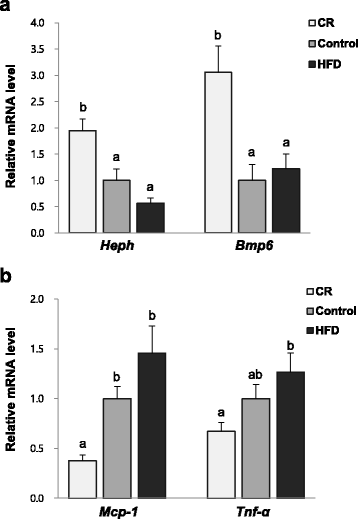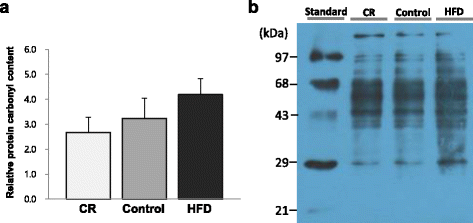Hepatic iron storage is related to body adiposity and hepatic inflammation
- PMID: 28228829
- PMCID: PMC5307864
- DOI: 10.1186/s12986-017-0169-3
Hepatic iron storage is related to body adiposity and hepatic inflammation
Abstract
Background: Obesity has been reported to be associated with iron deficiency. However, few studies have investigated iron status in low adiposity. To investigate whether body adiposity was associated with altered hepatic iron status, we compared liver iron levels and markers involved in inflammation and iron absorption in obese, control, and mildly calorie restricted mice.
Methods: Seven week old C57BL/6 mice were fed control (10% kcal fat, Control) or high fat (60% kcal fat, HFD) diets, or reduced amount of control diet to achieve 15% calorie restriction (CR) for 16 weeks. Hepatic non-heme iron content and ferritin protein level, and hematocrit and hemoglobin levels were determined to assess iron status. Hepatic expression of Mcp-1 and Tnf-α were measured as hepatic inflammatory markers. Hepatic hepcidin (Hamp) and Bmp6, and duodenal Dmt1, Dcyt1b, hephaestin (Heph) and ferroportin mRNA levels were measured as factors involved in regulation of iron absorption.
Results: Hepatic non-heme iron and ferritin protein levels were significantly higher in the CR group compared with the Control group, and significantly lower in the HFD group. These two iron status markers showed significantly negative correlations with the amount of white adipose tissue (r = -0.689 for hepatic non-heme iron and r = -0.740 for ferritin). Hepatic Mcp-1 and Tnf-α mRNA levels were significantly lower in the CR compared with the HFD (74 and 47% lower) and showed significantly negative correlations with hepatic non-heme iron levels (Mcp-1: r = -0.557, P < 0.05; Tnf-α: r = -0.464, P < 0.05). Hepatic Hamp mRNA levels were lower in the HFD and higher in the CR groups compared with the Control group, which could be a response to maintain iron homeostasis. Duodenal Dcyt1b mRNA levels were higher in the CR group compared with the HFD group and duodenal Heph mRNA levels were higher in the CR group than the Control group.
Conclusion: We showed that body adiposity was inversely correlated with liver iron status. Low inflammation levels in hepatic milieu and enhanced expression of duodenal oxidoreductases induced by calorie restriction could have contributed to higher iron status.
Keywords: Body adiposity; Duodenal iron transporter; Hepatic non-heme iron; Hepcidin; Iron absorption; Mild calorie restriction.
Figures





References
-
- Wolrd Health Organization . Micronutrient deficiencies. Iron deficiency anaemia. Wolrd Health Organization. 2015.
LinkOut - more resources
Full Text Sources
Other Literature Sources
Miscellaneous

